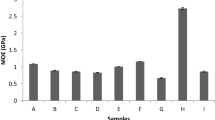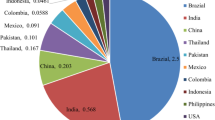Abstract
This study aimed to assess the potential usage of balsa wood to produce cement-bonded particleboards as well as to study the effects of accelerated carbonation on the cement-bonded balsa particleboard. Particleboards were subjected to two different curing conditions, (1) conventional curing: control—curing for 48 h in a climatic chamber, followed by 25 days in a saturated environment (98 ± 2%) in sealed plastic bags at 23 °C, (2) accelerated carbonation—curing for 48 h in a climatic chamber, and then in environment with CO2 (24 h concentration of 15%), followed by 24 days in a saturated environment (98 ± 2%) in sealed plastic bags at 23 °C. After 28 days of curing, the particleboards degree of carbonation was evaluated by TG-DTG and XRD analysis. Thermal, physical and mechanical characterizations were conducted following the recommendations of ASTM-E1530 and DIN: 310, 322, 323 standards, respectively. Accelerated carbonation decreased the portlandite content and increased of calcium carbonate content of the studied particleboards. Thermal properties showed that the particleboards could be used as an insulation material in accordance to European Standard (BS EN 13986). Physical and mechanical properties of the studied materials showed that they are potential building particleboard, because this material satisfied the requirements of ISO 8335 standard.




Similar content being viewed by others
References
Frybort S, Mauritz R, Teischinger A, Müller U (2008) Cement bonded composites—a mechanical review. BioResources 3:602–626
Nasser RA, Salem MZM, Al-Mefarrej HA, Aref IM (2016) Use of tree pruning wastes for manufacturing of wood reinforced cement composites. Cem Concr Compos 72:246–256. https://doi.org/10.1016/j.cemconcomp.2016.06.008
Kalaycıoglu H, Nemli G (2006) Producing composite particleboard from kenaf (Hibiscus cannabinus L.) stalks. Ind Crops Prod 24:177–180. https://doi.org/10.1016/j.indcrop.2006.03.011
Nozahic V, Amziane S (2012) Influence of sunflower aggregates surface treatments on physical properties and adhesion with a mineral binder. Compos Part A Appl Sci Manuf 43:1837–1849. https://doi.org/10.1016/j.compositesa.2012.07.011
Guntekin E, Karakus B (2008) Feasibility of using eggplant (Solanum melongena) stalks in the production of experimental particleboard. Ind Crops Prod 27:354–358. https://doi.org/10.1016/j.indcrop.2007.12.003
Babatunde A (2011) Durability characteristics of cement-bonded particleboards manufactured from maize stalk residue. J For Res 22:111–115. https://doi.org/10.1007/s11676-011-0135-2
Zhou XW, Zheng F, Li HG, Lu CL (2010) An environment-friendly thermal insulation material from cotton stalk fibers. Energy Build 42:1070–1074. https://doi.org/10.1016/j.enbuild.2010.01.020
Aggarwal LK, Agrawal SP, Thapliyal PC, Karade SR (2008) Cement-bonded composite boards with arhar stalks. Cem Concr Compos 30:44–51. https://doi.org/10.1016/j.cemconcomp.2007.07.004
Ashori A, Tabarsa T, Sepahvand S (2012) Cement-bonded composite boards made from poplar strands. Constr Build Mater 26:131–134. https://doi.org/10.1016/j.conbuildmat.2011.06.001
Borrega M, Ahvenainen P, Serimaa R, Gibson L (2015) Composition and structure of balsa (Ochroma pyramidale) wood. Wood Sci Technol 49:403–420. https://doi.org/10.1007/s00226-015-0700-5
Fengel D, Wegener G (2003) Wood: chemistry, ultrastructure, reactions. Verlag Kessel, Remagen
Hu XP, Hsieh YL (2001) Effects of dehydration on the crystalline structure and strength of developing cotton fibers. Text Res J Princet 71:231–239. https://doi.org/10.1177/004051750107100308
Almeida AEFS, Tonoli GHD, Santos SF, Savastano H Jr (2013) Improved durability of vegetable fiber reinforced cement composite subject to accelerated carbonation at early age. Cem Concr Compos 42:49–58. https://doi.org/10.1016/j.cemconcomp.2013.05.001
Santos SF, Schmidt R, Almeida AEFS, Tonoli GHD, Savastano H Jr (2015) Supercritical carbonation treatment on extruded fibre-cement reinforced with vegetable fibres. Cem Concr Compos 56:84–94. https://doi.org/10.1016/j.cemconcomp.2014.11.007
Cuéllar-Franca RM, Azapagic A (2015) Carbon capture, storage and utilisation technologies: a critical analysis and comparison of their life cycle environmental impacts. J CO2 Util 9:82–102. https://doi.org/10.1016/j.jcou.2014.12.001
Fernández Bertos M, Simons SJR, Hills CD, Carey PJ (2004) A review of accelerated carbonation technology in the treatment of cement-based materials and sequestration of CO2. J Hazard Mater 112:193–205. https://doi.org/10.1016/j.jhazmat.2004.04.019
Borges PHR, Costa JO, Milestone NB, Lynsdale CJ, Streatfield RE (2010) Carbonation of CH and C–S–H in composite cement pastes containing high amounts of BFS. Cem Concr Res 40:284–292. https://doi.org/10.1016/j.cemconres.2009.10.020
Wang L, Chen SS, Tsang DCW, Poon C-S, Dai J-G (2017) CO2 curing and fibre reinforcement for green recycling of contaminated wood into high-performance cement-bonded particleboards. J CO2 Util 18:107–116. https://doi.org/10.1016/j.jcou.2017.01.018
NBR 5733 (1991) Cimento portland com alta resistencia inicial. Rio de Janeiro, Brazil
Morais JPS, Rosa MF, Marconcini JM (2010) Procedimentos para análise lignocelulósica. Embrapa Algodão, p 54
Tappi T 222 om-88 (1988) Acid-insoluble lignin in wood and pulp
Tappi T 204 cm-97 (2007) Solvent extractives of wood and pulp
Langford JI, Wilson AJC (1978) Scherrer after sixty years: a survey and some new results in the determination of crystallite size. J Appl Crystallogr 11:102–113. https://doi.org/10.1107/S0021889878012844
French AD (2014) Idealized powder diffraction patterns for cellulose polymorphs. Cellulose 21:885–896. https://doi.org/10.1007/s10570-013-0030-4
Nam S, French AD, Condon BD, Concha M (2016) Segal crystallinity index revisited by the simulation of X-ray diffraction patterns of cotton cellulose Iβ and cellulose II. Carbohydr Polym 135:1–9. https://doi.org/10.1016/j.carbpol.2015.08.035
Nishiyama Y, Langan P, Chanzy H (2002) Crystal structure and hydrogen-bonding system in cellulose Iβ from synchrotron X-ray and neutron fiber diffraction. J Am Chem Soc 124:9074–9082. https://doi.org/10.1021/ja0257319
Hachmi M, Moslemi AA, Campbell AG (1990) A new technique to classify the compatibility of wood with cement. Wood Sci Technol 24:345–354. https://doi.org/10.1007/BF00227055
Cabral MR, Nakanishi EY, Fiorelli J (2017) Evaluation of the effect of accelerated carbonation in cement-bagasse panels after cycles of wetting and drying. J Mater Civ Eng 29:04017018. https://doi.org/10.1061/(ASCE)MT.1943-5533.0001861
Mohr BJ, Biernacki JJ, Kurtis KE (2007) Supplementary cementitious materials for mitigating degradation of kraft pulp fiber-cement composites. Cem Concr Res 37:1531–1543. https://doi.org/10.1016/j.cemconres.2007.08.001
ASTM E1530 (2011) Standard test method for evaluating the resistance to thermal transmission of materials by the guarded heat flow meter technique. Philadelphia, United States
DIN EN 322 (1993) Wood-based panels. Determination of moisture content. Brussels, Belgium
DIN EN 323 (1993) Wood-based panels. Determination of density. Brussels, Belgium
DIN EN 310 (1993) Wood-based panels. Determination of modulus of elasticity in bending and of bending strength. Brussels, Belgium
Semple KE, Cunningham RB, Evans PD (2002) The suitability of five Western Australian mallee eucalypt species for wood-cement composites. Ind Crops Prod 16:89–100. https://doi.org/10.1016/S0926-6690(02)00012-2
Malek S, Gibson LJ (2017) Multi-scale modelling of elastic properties of balsa. Int J Solids Struct 113–114:118–131. https://doi.org/10.1016/j.ijsolstr.2017.01.037
Fiorelli J, Gomide CA, Lahr FAR, Nascimento MF, Sartori DL, Ballesteros JEM, Bueno SB, Belini UL (2014) Physico-chemical and anatomical characterization of residual lignocellulosic fibers. Cellulose 21:3269–3277. https://doi.org/10.1007/s10570-014-0398-9
Fan M, Ndikontar MK, Zhou X, Ngamveng JN (2012) Cement-bonded composites made from tropical woods: compatibility of wood and cement. Constr Build Mater 36:135–140. https://doi.org/10.1016/j.conbuildmat.2012.04.089
Jorge FC, Pereira C, Ferreira JMF (2004) Wood-cement composites: a review. Holz Roh Werkst 62:370–377. https://doi.org/10.1007/s00107-004-0501-2
Chakraborty S, Kundu SP, Roy A, Adhikari B, Majumder SB (2013) Effect of jute as fiber reinforcement controlling the hydration characteristics of cement matrix. Ind Eng Chem Res 53:1252–1260. https://doi.org/10.1021/ie300607r
Moniruzzaman M, Ono T (2013) Separation and characterization of cellulose fibers from cypress wood treated with ionic liquid prior to laccase treatment. Bioresour Technol 127:132–137. https://doi.org/10.1016/j.biortech.2012.09.113
Wikberg H, Maunu SL (2004) Characterisation of thermally modified hard- and softwoods by 13C CPMAS NMR. Carbohydr Polym 58:461–466. https://doi.org/10.1016/j.carbpol.2004.08.008
Penttilä PA, Kilpeläinen P, Tolonen L, Suuronen JP, Sixta H, Willför S, Serimaa R (2013) Effects of pressurized hot water extraction on the nanoscale structure of birch sawdust. Cellulose 20:2335–2347. https://doi.org/10.1007/s10570-013-0001-9
Andersson S, Wikberg H, Pesonen E, Maunu SL, Serimaa R (2004) Studies of crystallinity of Scots pine and Norway spruce cellulose. Trees Struct Funct 18:346–353. https://doi.org/10.1007/s00468-003-0312-9
Correia VC, Santos V, Sain M, Santos SF, Leão AL, Savastano H Jr (2016) Grinding process for the production of nanofibrillated cellulose based on unbleached and bleached bamboo organosolv pulp. Cellulose 23:2971–2987. https://doi.org/10.1007/s10570-016-0996-9
Borrega M, Gibson LJ (2015) Mechanics of balsa (Ochroma pyramidale) wood. Mech Mater 84(75–90):015. https://doi.org/10.1016/j.mechmat.2015.01.014
Rostami V, Shao Y, Boyd AJ, He Z (2012) Microstructure of cement paste subject to early carbonation curing. Cem Concr Res 42:186–193. https://doi.org/10.1016/j.cemconres.2011.09.010
Taylor HFW (1997) Cement chemistry. ThomasTelford, London
Pizzol VD, Mendes LM, Frezzatti L, Savastano H Jr, Tonoli GHD (2014) Effect of accelerated carbonation on the microstructure and physical properties of hybrid fiber-cement composites. Miner Eng 59:101–106. https://doi.org/10.1016/j.mineng.2013.11.007
Young R (1993) The rietveld method. Oxford University Press, London
Wang L, Chen SS, Tsang DCW, Poon CS, Shih K (2016) Value-added recycling of construction waste wood into noise and thermal insulating cement-bonded particleboards. Constr Build Mater 125:316–325. https://doi.org/10.1016/j.conbuildmat.2016.08.053
Khedari J, Suttisonk B, Pratinthong N, Hirunlabh J (2001) New lightweight composite construction materials with low thermal conductivity. Cem Concr Compos 23:65–70. https://doi.org/10.1016/S0958-9465(00)00072-X
BSI, BS EN 13986 (2004) Wood-based panels for use in construction—characteristics, evaluation of conformity and marking
Xu Y, Chung DDL (2000) Effect of sand addition on the specific heat and thermal conductivity of cement. Cem Concr Res 30:59–61. https://doi.org/10.1016/S0008-8846(99)00206-9
ISO 8335 (1987) Cement-bonded particleboards—boards of Portland or equivalent cement reinforced with fibrous wood particles. Switzerland
Ferraz JM, Menezzi CHS, Teixeira DE, Martins SA (2011) Effects of treatment of coir fiber and cement/fiber ratio on properties of cement-bonded composites. BioResources 6:3481–3492. https://doi.org/10.15376/biores.6.3.3481-3492
Okino EYA, Souza MR, Santana MAE, Alves MVS, Sousa ME, Teixeira DE (2004) Cement-bonded wood particleboard with a mixture of eucalypt and rubberwood. Cem Concr Compos 26:729–734. https://doi.org/10.1016/S0958-9465(03)00061-1
Cabral MR, Nakanishi EY, Fiorelli J (In press) Cement-bonded panels produced with sugarcane bagasse cured by accelerated carbonation. J Mater Civ Eng. https://doi.org/10.1061/(ASCE)MT.1943-5533.0002301
Acknowledgements
The authors are sincerely thankful to the Brazilian financial support from Conselho Nacional de Desenvolvimento Científico e Tecnológico (CNPq, Brazil) [Grant Nos. 464532/2014-0 and 312151/2016-0] and company Infibra S.A. Coordenação de Aperfeiçoamento de Pessoal de Nível Superior (CAPES, Brazil) and Fundação de Amparo à Pesquisa do Estado de São Paulo (FAPESP) [Grant No. 2016/07372-9].
Author information
Authors and Affiliations
Corresponding author
Ethics declarations
Conflict of interest
The authors declare that there is no conflict of interest.
Rights and permissions
About this article
Cite this article
Cabral, M.R., Nakanishi, E.Y., dos Santos, V. et al. Evaluation of accelerated carbonation curing in cement-bonded balsa particleboard. Mater Struct 51, 52 (2018). https://doi.org/10.1617/s11527-018-1179-y
Received:
Accepted:
Published:
DOI: https://doi.org/10.1617/s11527-018-1179-y




